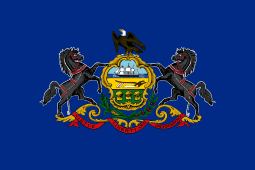Arthur James (politician)
Arthur Horace James (July 14, 1883 – April 27, 1973) was an American lawyer, politician, and judge. A Republican, he served as the 14th Lieutenant Governor (1927–1931) and the 31st Governor (1939–1943) of Pennsylvania.
Arthur James | |
|---|---|
| 31st Governor of Pennsylvania | |
| In office January 17, 1939 – January 19, 1943 | |
| Lieutenant | Samuel Lewis |
| Preceded by | George Earle |
| Succeeded by | Edward Martin |
| 14th Lieutenant Governor of Pennsylvania | |
| In office January 18, 1927 – January 20, 1931 | |
| Governor | John Stuchell Fisher |
| Preceded by | David Davis |
| Succeeded by | Edward Shannon |
| Personal details | |
| Born | Arthur Horace James July 14, 1883 Plymouth, Pennsylvania |
| Died | April 27, 1973 (aged 89) |
| Political party | Republican |
| Spouse(s) | Ada Morris (1912–1935; her death) Emily Radcliffe Case (after 1941) |
| Alma mater | Dickinson School of Law |
Early life and career
The oldest of eight children, Arthur James was born in Plymouth, Pennsylvania, to James D. and Rachel (née Edwards) James.[1] His parents were Welsh immigrants; his father worked as a mining foreman and his mother as a schoolteacher.[2] As a child, he worked as a breaker boy and mule driver in the coal mines of northeastern Pennsylvania.[3] His mother died while he was still in grammar school, and his father subsequently tutored him and his siblings.[4]
After graduating from Plymouth High School in 1901, James studied at Dickinson Law School in Carlisle.[1] While attending Dickinson, he was a member of the varsity basketball team and continued to work as a mule driver in Plymouth during summers.[3] In 1904, he earned his law degree and was admitted to the bar.[4] He entered into private practice in Plymouth, later opening another office in Wilkes-Barre.[4] In 1912, he married Ada Morris, to whom he remained married until her early death in 1935; the couple had one daughter, and a son who died during infancy.[4] From 1920 to 1926, he served as district attorney of Luzerne County.[3]
In 1926, James was elected Lieutenant Governor of Pennsylvania after defeating his Democratic opponent, former state Senator W. Clayton Hackett, by 761,619 votes.[2] After serving one term under Governor John S. Fisher, he was elected as a judge of the Superior Court of Pennsylvania, serving from 1932 to 1939.[1]
Governor of Pennsylvania
In 1938, incumbent Democratic Governor George H. Earle unsuccessfully challenged Republican James J. Davis for a seat in the United States Senate. James entered the race to succeed Earle as governor, campaigning to reduce taxes, balance the budget, make the state more attractive to businesses, and end political corruption.[3] A strong opponent of Governor Earle's "Little New Deal," he promised to "make a bonfire of all the laws passed by the 1937 legislature."[4] In the Republican primary, he defeated former Governor Gifford Pinchot, whom James claimed would sell the Republican Party "down the New Deal river," by a margin of 486,000 votes.[3] He was elected the 31st Governor of Pennsylvania in the general election, defeating Democrat Charles Alvin Jones by more than 279,000 votes.[4] He received more votes than any previous gubernatorial candidate in Pennsylvania.[3]
During his tenure as governor, James created the state Department of Commerce and the Anthracite Emergency Commission, extended the Pennsylvania Turnpike, signed a bill banning sit-down strikes, strengthened the civil service, and reinforced liquor control laws.[1] He also turned the state's $58 million deficit into a $75 million surplus.[2] During the early part of World War II, he established the State Council of Defense and the Selective Service Board and later created the Pennsylvania Reserve Defense Corps and the Citizens' Defense Corps for homeland defense.[3] At the 1940 Republican National Convention in Philadelphia, he was nominated for President of the United States by Joseph N. Pew, Jr..[2] He lasted for all six ballots, and endorsed the eventual winner, Wendell Willkie.[1]
Later life and death
After serving one term as governor, James resumed his law practice. He married Emily Radcliffe Case, who had also lost her spouse, in 1941.[4] In 1944, Governor Edward Martin appointed James to fill a vacancy on the Superior Court, on which he had previously served.[3] However, he was narrowly defeated to remain on the court in 1944, losing to Democrat F. Clair Ross.[1] He returned to Plymouth, where he practiced law and worked with local organizations for nearly thirty years.
James died at age 89, and is buried in Hanover Green Cemetery.[1]
References
- "Pennsylvania Governor Arthur Horace James". National Governors Association.
- Beers, Paul B. (1980). Pennsylvania Politics Today and Yesterday: The Tolerable Accommodation. Pennsylvania State University Press.
- "Arthur Horace James (1883-1973) Historical Marker". Explore PA History.
- "Governor Arthur H. James". Pennsylvania Historical & Museum Commission.
External links
| Political offices | ||
|---|---|---|
| Preceded by George Earle |
Governor of Pennsylvania 1939 – 1943 |
Succeeded by Edward Martin |
| Preceded by David Davis |
Lieutenant Governor of Pennsylvania 1927 – 1931 |
Succeeded by Edward Shannon |
| Party political offices | ||
| Preceded by William Schnader |
Republican nominee for Governor of Pennsylvania 1938 |
Succeeded by Edward Martin |
| Preceded by David Davis |
Republican nominee for Lieutenant Governor of Pennsylvania 1926 |
Succeeded by Edward Shannon |

